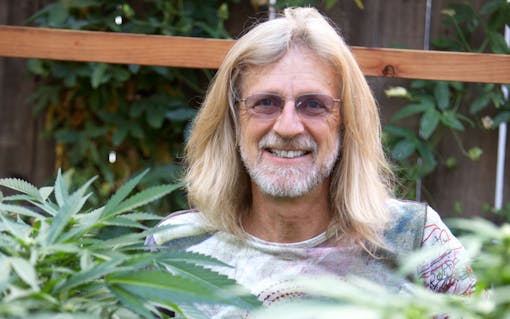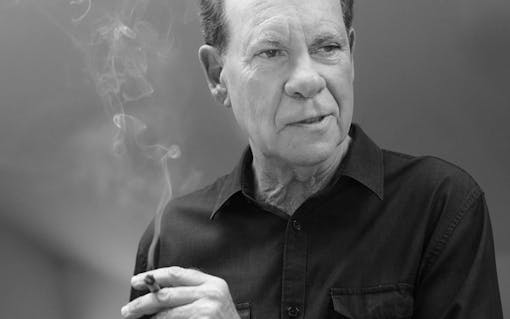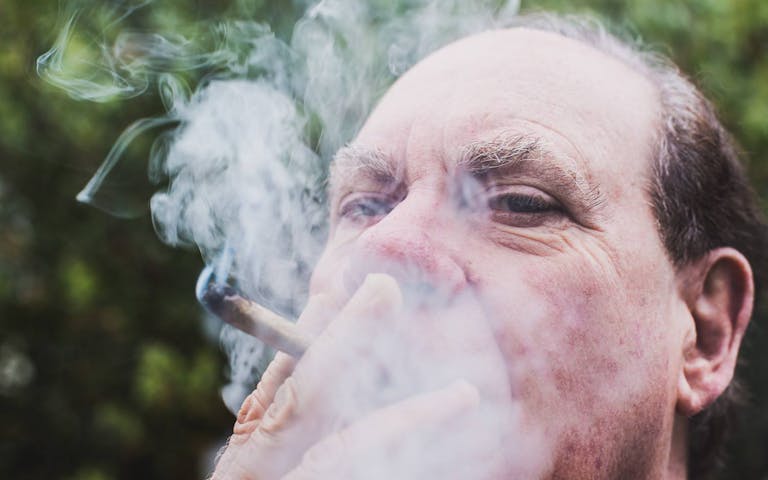It’s almost impossible to get famous for growing cannabis.
With the notable exception of certain harvest competitions and Cannabis Cups, there currently exists little by way of public acclaim for those who cultivate the world’s finest examples of the plant—a most regrettable oversight that exists in large part due to the forced anonymity of prohibition.
But also because most of the scant attention that does exist in this realm has been lavished upon cannabis breeders, who cross one strain with another to create entirely new varietals. Some of these go on to become household names (at least in households with a bong in them).
So, whether you visit a dispensary or buy from an underground dealer, it’s far more likely that you know what strain you’re puffing on (OG Kush or Sour Diesel) than who put the seeds in the ground, or nursed a cutting to maturity. Similarly, you’ll likely know if the apple you’re about to make into a pie (or a pipe) is a Golden Delicious or a Fuji, but you probably wouldn’t know who farmed the orchard.
The difference between growing really good cannabis and growing award-winning cannabis is a devotion of time and attention to detail that only very rarely gets properly rewarded. Though it should.
How do I know for sure that cannabis consumers are overly obsessed with strains, and don’t think enough about growers? Because when I tell people I write about weed for a living, one of the first things they ask is my favorite strain. Nobody ever asks my favorite grower.
But will it always be this way? Maybe not.
Think about wine, where we’re typically given both data points—the varietal of grape and the winemaker. Those who shop primarily based on price will either look for a cheap Merlot or Chardonnay or simply pick “red” or “white,” regardless of where or how the grapes were grown and processed. Meanwhile, those who base their decision on quality or value will consider both varietal and vineyard. That’s why two different bottles that both hold 750ml of wine made from the same type of grape in the same year and with nearly identical alcohol potency can sell for anywhere from $3 to $300 or more.
Growing the finest cannabis on earth has never been about the money. Sure, everybody loves to be well-compensated for their labor, but the truth is that the difference between growing really good cannabis and growing award-winning cannabis is a devotion of time and attention to detail that only very rarely gets properly rewarded. Though it should. As should the accomplishments of all cannabis growers, whether legal or underground, who ply their trade honorably, and to the highest standards—particularly the rare few who come along to change the game.
The Inventor of Sinsemilla

Shot by Julia Sumpter for Leafly at From The Soil Farms
Spanish for “without seeds,” the word sinsemilla refers to a process by which growers remove all male plants from the garden as early as possible, leaving only female plants behind to fully mature. This serves two functions: first, only female cannabis flowers produce resin sufficiently high in THC to be worth smoking; and second, they stop producing resin as soon as they’re pollinated by a male plant. So removing the male plants means more space for prized females, and that those females will go unpollinated so they can produce the most resin possible, without producing any seeds.
In North America, this practice became widespread in the 1970s. Cannabis smokers long accustomed to spending considerable time pulling all of the seeds out of their stash quickly grew accustomed to a higher quality, higher potency, seed-free experience with sinsemilla.
As the name implies, popular lore attributes this game-changing breakthrough to an unknown grower at work in the vast sativa fields of Mexico, while others claim that some Humboldt County hermit developed the technique. But leading cannabis researcher and journalist Fred Gardner says both those theories ignore compelling evidence that “seedless” growing is far older than all that.
“Northern California growers may claim to have ‘invented’ sinsemilla,” Gardner wrote in Counterpunch, “but old photos of fields in India and Morocco—any place where cannabis has been grown traditionally—depict big, fat colas, meaning the growers knew to pull the males and let the female flowers put out maximum resin.”

George Van Patten (a.k.a. “Jorge Cervantes”)
Full disclosure: I directed all three installments of Jorge Cervantes Ultimate Grow—a series of instructional videos that we had a really, really good time making.
Since 1983, George Van Patten (writing under the pen name Jorge Cervantes) has sold over one million self-published cannabis cultivation books, providing solid information and detailed instructions to countless growers around the world, who’ve in turn provided the rest of us with an unquantifiable amount of really high grade cannabis. He’s also a guy who clearly loves both cannabis and those who grow it.
“Why have one of those regular jobs—and hate it—when you can garden instead, growing this wonderful plant that you love?”
In fact, the earliest iteration of Van Patten’s “grow bible” had its roots in his own carefully collected field notes, based on his many years as an underground grower in Mexico and Southern California. After photocopying those detailed notes and sharing them many, many times with fellow cultivators, he finally printed up a small batch of self-published books to save himself the trouble of making copies only to find he had a perennial bestseller on his hands.
“I got into this because I find growing cannabis exciting, and I just didn’t fit in doing anything else,” he told me once in an interview. “So why have one of those regular jobs—and hate it—when you can garden instead, growing this wonderful plant that you love? Also, back in the late 1970s, I thought I was getting in on the ground floor before it got legal. Turns out I got in on the underground floor, but I don’t regret it at all.”
Even as the popular conception of cannabis cultivation has shifted to large, professionally operated production facilities, Van Patten continues to focus on those cultivating in a backyard, basement, or small plot—whether hoping to grow their own medicine, make ends meet, pay off the mortgage, put the kids through school, or even rebuild their lives after an arrest for cannabis has made it hard to find work in the aboveground economy. At cannabis conferences and festivals around the world, grateful growers line up for long stretches to thank him for helping them avoid that “regular job.”
Mahmoud ElSohly
The only location in the United States that’s ever been federally licensed by the DEA to grow cannabis is a 12-acre farm and indoor cultivation facility at the University of Mississippi. First opened in 1968, and overseen since its inception by the National Institute on Drug Abuse (NIDA), the fully-legal operation primarily supplies cannabis to federally approved research studies, with “a typical outdoor growing season yielding over 1,100 pounds of plant material, while an indoor season yields about 22 pounds.”
“It didn’t even resemble cannabis,” according to Sisley, who had the samples lab tested and found that some had high levels of mold or trace levels of lead.
In the past, NIDA had been notorious for refusing this monopolized supply to any study seeking to explore the plant’s potential medicinal benefits, while wholly supporting poorly designed studies seeking to exaggerate its harms. Researchers unsuccessfully battled the DEA for decades in hopes of ending this NIDA blockade.
Meanwhile, in 1978, the Ole Miss farm expanded its mission by beginning to supply free medical cannabis to individual patients who qualified under something called the Compassionate Investigational New Drug program. The tightly controlled federal program peaked at just thirty members before being disbanded in 1992 under political pressure from the George H.W. Bush Administration. Those few patients already enrolled, however, were grandfathered in, and at least four of them continue to get monthly shipments to this day.
Irv Rosenthal, a stockbroker living in Ft. Lauderdale, Florida, has been receiving a tin with 300 pre-rolled joints every month for long enough to have smoked well over 130,000 of them. He never comments on the quality, probably to spare the feelings of Mahmoud ElSohly, a professor of pharmaceutics and head of the University of Mississippi cannabis facility since 1980.
Asked what’s changed most during his time as America’s only fully legal grower, ElSohly told STAT news, basically, that he’s had to up his grow game along with everyone else.
“In the early days, I think the maximum potency that we were producing was in the 3 or 4 percent THC range. It was because of demand from researchers and because it was consistent with what was on the streets at the time.
Lately, because some investigators wanted to get material with much higher potency, we started producing material that had 8 percent THC. The investigators administered that to subjects in a clinical trial and the most experienced subjects could not tolerate it. They called and said, ‘This is too strong.’ And I said, ‘We know that, but that’s what you requested.’”
ElSohly takes a combative tone throughout the interview, complaining that the research community looks at him “like the enemy,” and “badmouths” his work.
Case in point, in 2017, Dr. Sue Sisley, head of a landmark study of cannabis as a treatment for 76 military veterans suffering from chronic post-traumatic stress disorder, went public with complaints about the quality of cannabis ElSohly and the Ole Miss facility provided for her study.
“It didn’t even resemble cannabis,” according to Sisley, who had the samples lab tested and found that some had high levels of mold or trace levels of lead, while others diverged significantly from their promised potency. One sample that Ole Miss labeled 13% THC re-tested at only 8%.
And yet they remain the nation’s sole supplier of research cannabis. In 2016, the DEA did begin taking applications for additional bulk growing licenses, theoretically ending the monopoly on supply. But so far, despite receiving at least 16 applications, none have been approved.
Ed Rosenthal

(Courtesy of Ed Rosenthal)
From its first issue in 1974, High Times magazine featured Ed Rosenthal’s coverage of cannabis cultivation, with a special focus on the increasing number of people choosing to grow their own for the first time. Instantly, his advice column—“Ask Ed: Your Marijuana Questions Answered”—made him one of the very few recognized experts on a subject that would remain largely sub rosa for the next forty years.
The column remains in print today, and Rosenthal has founded Quick Trading Publishing to put out his own books and the writings of an impressive roster of fellow cannabis authors and researchers. He’s also been a tireless advocate and activist for the cause of medical cannabis and legalization.
In 1999, Rosenthal’s adopted home of Oakland, California appointed him an “Officer of the City” and tasked him with cultivating cannabis to supply local medical patients. Three years later, the federal government raided his city-supported grow operation and arrested him. At trial, Rosenthal and his lawyer were barred from mentioning that he was growing for medical patients, or that he did so at the City of Oakland’s request.
After voting to convict, several jurors later denounced the verdict when they learned the circumstances.
According to a New York Times account of the case, Rosenthal “faced a possible sentence of 100 years in prison and a potential fine of $4.5 million,” but U.S. District Court Judge Charles Breyer sentenced him to just one day in prison. Rosenthal appealed anyway, and in 2006, the 9th Circuit Appeals Court subsequently overturned his criminal conviction.
Next time you hear someone talk about how entrepreneurs, politicians, or investors are leading the charge towards legalization, remember than none of this would be possible without the campaign of civil disobedience.
A few months later, however, the U.S. Attorney’s Office re-indicted him, even though the judge in the case had publicly vowed not to add any more prison time than the one day already served. Again barred from mentioning medical cannabis or Oakland’s tacit approval of his grow operation, a new jury convicted Rosenthal, and true to his word, the judge added no new prison time.
But the Feds did succeed in sending a warning to every other medical cannabis grower stating that state law would not stop the Department of Justice or the DEA from banging down your door. Nevertheless, growers persisted.
So next time you hear someone talk about how entrepreneurs, politicians, or investors are leading the charge towards legalization, remember than none of this would be remotely possible without the incredible and sustained campaign of civil disobedience against these terrible laws spearheaded by the world’s underground cannabis cultivators—who vowed to “Overgrow the Government” and succeeded.
Professor Afghani
If not for cannabis prohibition, the idea of growing cannabis indoors would likely never have occurred to anyone. Why spend the time and money necessary to recreate the plant’s natural environment if you’re not actively trying to avoid detection? Or, put another way, have you ever heard of winemakers growing indoor grapes or brewers growing indoor hops?
The earliest systems for indoor growing reflected this pioneering DIY spirit, with plants remaining in soil, hand watered, under janky lights that had been repurposed from other uses.
Without any clear models to follow, the first generation of indoor growers not only had to adjust to life without the sun (or wind, or rain), they had to pretty much invent ways to replace them through trial and error. The earliest systems for indoor growing reflected this pioneering DIY spirit, with plants remaining in soil, hand watered, under janky lights that had been repurposed from other uses. The cannabis emanating from such ad-hoc setups was notoriously sparse and uninspiring.
The move to more sophisticated hydroponics systems in the 1970s was a cultivation game changer all its own, but with the history of “soil-less” agriculture actually dating back to the storied Hanging Gardens of Babylon, and many of the modern advances in the field made by NASA scientists, it’s kind of hard to find a cannabis grower to pin the medal on. So let’s fast forward to 1996, and the publication in High Times of a landmark article called “The Million Dollar Growroom.”
“In this well-ordered garden, row upon row of buds were planted in rockwool cubes over slabs in trays containing nutrient solution, which dripped back down into the reservoirs,” reports Danny Danko, the magazine’s current cultivation editor. “This was not some closet grow with a couple of buckets of smelly dirt, but a laboratory setup capable of real production. Professor Afghani’s straight-forward article is a step-by-step review of the basics—from starting mother plants and rooting clones to irrigating the flower room and utilizing ventilation and CO2 enrichment to harvest over a million dollars’ worth of pot in a single year.”
Professor Afghani never revealed his true identity, even to his editors, but he cared passionately about sharing his hard-fought wisdom on cannabis cultivation with the world. By bringing indoor growing to a new level of sophistication and efficiency, he most certainly changed the game.
Lead image courtesy of Ed Rosenthal





